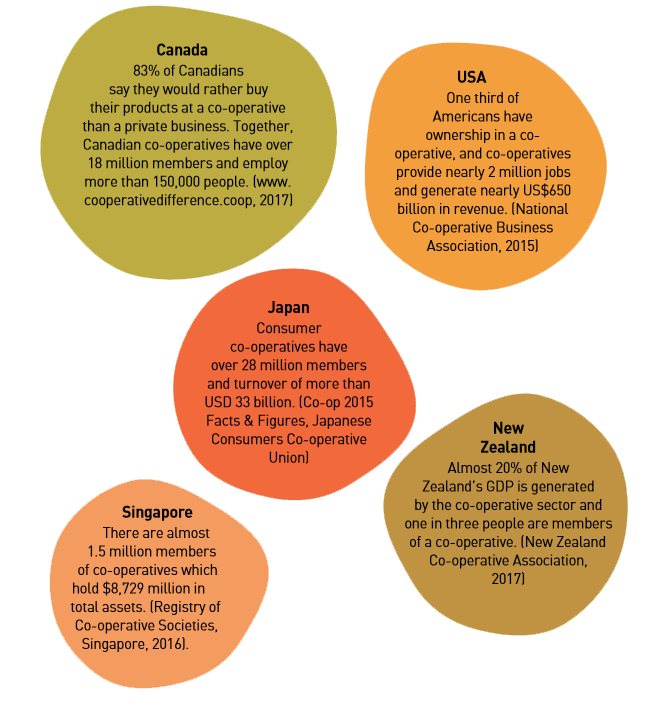PART ONE: UNDERSTANDING CO-OPERATIVES
Co-operatives today
Co-operatives are strong social and economic forces, with the ICA reporting that across the world co-operatives have approximately one billion people as members, about 250 million employees and US$2.2 trillion in turnover. Co-operatives improve the livelihood of nearly 3 billion people. To put that into perspective, just 328 million people own shares traded on stock markets. (Co-operatives UK, 2012)
In Australia, it is difficult to get reliable statistics on the co-operative sector. The Australian Business Register categorises many co-operatives as other types of entities, and other entities as co-operatives. For a variety of historical reasons, financial co-operatives, as well as some cooperatives in other sectors such as agriculture, are registered under the federal Corporations Act with a co-operative constitution rather than under state-based co-operatives acts.
The Australian Institute cites that eight in every ten Australians are members of a co-operatively or mutually owned enterprise – an estimated 13.5 million members.
In 2012 there were around 1,700 general co-operatives registered in states and territories in Australia, compared to 2,350 in 2000 (Australian Bureau of Statistics, “Regulation of Cooperatives in Australia”, 1301.0 – Year Book Australia, 2012). The drop in co-operative numbers in Australia is curious, given the growth of the co-operative movement overseas. It is thought to be partly due to restrictions and additional compliance costs in the regulatory environment causing a decline in new co-operatives being formed, and larger co-operatives and mutuals becoming companies to access external capital. Also contributing to the decline may be a lack of grassroots understanding and support for linkages, a low commitment to co-operation among co-operatives, a lack of training in the sector, and the lack in the past of a strong voice from cooperatives to develop a higher profile with the Australian public and governments.
The CNL addresses many of the historical disadvantages of registration under state-based cooperative legislation compared with registration under the Corporations Act, while preserving the advantages specialised co-operative legislation has always provided. For example, it enables all Australian co-operatives to issue co-operative capital units which enable co-operatives to access external capital without compromising member democratic control.
The Business Council for Co-operatives and Mutuals (BCCM), the national peak body, in its 2016 National Mutual Economy Report, estimated that the ‘Top 100’ co-operatives, credit unions and mutuals had a combined annual turnover of $30.5 billion in the 2014–2015 financial year, with 29 million active members. The state with the highest annual turnover was New South Wales (32% of the national total), followed by Western Australia and Victoria (both 27%). In five years, average annual turnover for the Top 100 grew by 18% while total combined assets for the group grew by 14%.
HASTINGS CO-OPERATIVE
Hastings Co-operative on the mid-north coast of New South Wales was established in 1916 with eight people working at their butter factory.
A century later, more than 270 people are employed running 15 businesses in Wauchope, Port Macquarie and Comboyne: two department stores, three IGA supermarkets, two Supa IGA Plus Liquor stores, one bottle shop, two service stations, a bulk fuel depot, two hardware and rural supplies stores, a café and a condiments range.
Co-operatives are considered a small but important part of the Australian economy. The co-operative rural sector contributes most in terms of GDP. The top two co-operatives in Australia in 2015 in terms of turnover were agricultural co-operatives – Co-operative Bulk Handling Ltd in Western Australia and Murray Goulburn Co-operative Co. Limited in Victoria (BCCM, 2016).
In 1999, credit unions, friendly societies and building societies became companies governed by the Corporations Law. Through amalgamations and the uptake of new technologies, they are a viable alternative today to Australia’s four major banks and remain very competitive.

